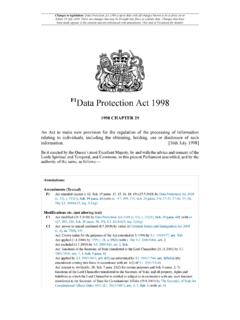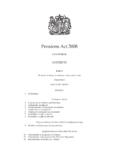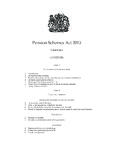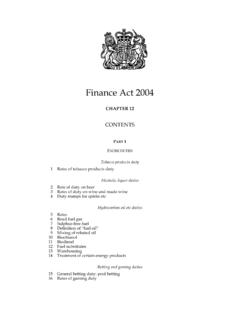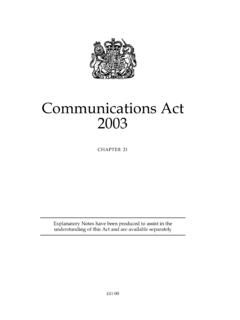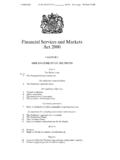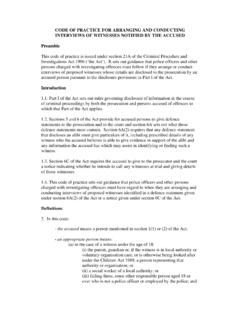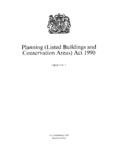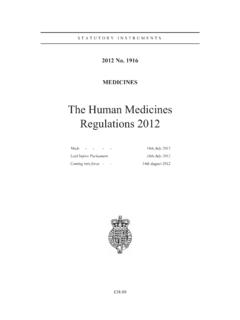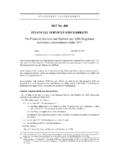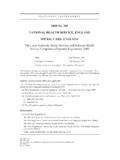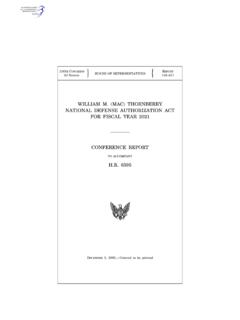Transcription of Statutory Instrument Practice - Legislation.gov.uk
1 Statutory Instrument Practice A guide to help you prepare and publish Statutory Instruments and understand the Parliamentary procedures relating to them - 5th edition (November 2017). Statutory Instrument Practice Page i Statutory Instrument Practice is published by The national Archives Crown copyright 2017. This publication is licensed under the terms of the Open Government Licence except where otherwise stated. Any enquiries regarding this publication should be sent to: Statutory Instrument Practice Page ii Preface This is the fifth edition of Statutory Instrument Practice (SIP) and replaces the edition published in November 2006. This edition has been prepared by the legislation Services team at The national Archives. We will contact you regularly to make sure that this guide continues to meet your needs, and remains accurate. If you would like to suggest additional changes to us, please email them to the SI Registrar.
2 Thank you to all of the contributors who helped us to update this edition. You can download SIP from: Practice . November 2017. Statutory Instrument Practice Page iii Contents PREFACE .. iii CONTENTS .. iv PART 1: INTRODUCTION .. 1. 1. ABOUT SIP AND Statutory INSTRUMENTS .. 1. How to use the Statutory Instrument Practice (SIP) Guide .. 1. An overview of the Statutory Instrument (SI) process .. 2. Some background to subordinate legislation .. 3. Types of Statutory 7. Parliament and Statutory Instruments .. 12. What is published and by what authority .. 14. Useful 16. PART 2: PARLIAMENTARY CONTROL AND SI CLASSES .. 18. 2. PARLIAMENTARY CONTROL AND PROCEDURES, AND SI CLASSES .. 18. What this part of the guide covers .. 18. Affirmative procedure .. 18. Negative procedure .. 21. Exceptional procedures .. 24. Other varieties of procedure .. 28. Other aspects of Parliamentary control .. 29. Parliamentary Control for Orders in 30.
3 Classes of SI .. 31. Requirement for Explanatory Memoranda for SIs laid before Parliament .. 33. Delivering Documents to Parliament .. 35. The 21 day rule' .. 37. Compatibility with the European Convention on Human 38. Procedures for EU legislation .. 38. Statutory Instrument Practice Page iv Procedures following the dissolution of Parliament .. 38. Procedure for Statutory Instruments made under pre-1948 Acts .. 41. PART 3: REQUIRED CONTENT .. 45. 3. REQUIRED CONTENT OF SIS AND ASSOCIATED DOCUMENTS .. 45. What this part of the guide covers .. 45. Different Classes of SI and required 45. Local and General SIs .. 45. Illustrating different SI elements .. 46. 49. Banners .. 56. 58. Subject headings .. 61. Titles of Statutory Instruments .. 64. Italic date information: made, laid and coming into force dates .. 68. Preamble and words of enactment .. 73. Interpretation, citation and commencement provisions .. 79. Extent and application 85.
4 Revocations and amendments .. 86. References to legislation and Command Papers .. 87. References to amended enactments in SIs .. 88. References to publications, documents, maps and plans .. 88. References to EU instruments .. 90. Explanatory parentheses for references .. 91. Signatures (including multiple signatures and date of making) .. 91. Footnotes .. 93. Schedules and shoulder notes .. 100. Explanatory Notes .. 100. Notes as to earlier Commencement Orders/Regulations .. 105. Statutory Instrument Practice Page v SIs resulting from membership of the European Union .. 106. PART 4: REGISTRATION, LAYING AND PUBLISHING .. 109. 4. VALIDATION, REGISTRATION, 109. What this part of the guide covers .. 109. Publishing .. 110. Templates for SIs and associated documents .. 112. SI template and validation service .. 115. Registration service .. 118. Checks carried out at registration .. 124. Correcting errors after submission through Publishing.
5 126. Laying .. 130. Date of laying .. 133. Laying and the printing programme .. 135. Laying SIs and associated documents .. 135. Publishing of SIs and Associated Documents .. 136. Withdrawing SIs .. 137. Exemptions from the requirement to 139. PART 5: SCRUTINY COMMITTEES .. 140. 5. SCRUTINY VIA PARLIAMENTARY COMMITTEES .. 140. What this part of the guide covers .. 140. The Joint Committee on Statutory Instruments (JCSI) and the Select Committee on Statutory Instruments (SCSI) .. 140. The Secondary legislation Scrutiny Committee .. 144. The Hybrid Instruments Committee .. 145. The House of Lords Delegated Powers and Regulatory Reform Committee and the House of Commons Regulatory Reform Committee .. 146. The Statutory Instruments Reference Committee .. 148. INDEX .. 149. Statutory Instrument Practice Page vi Statutory Instrument Practice Page vii PART 1: INTRODUCTION. 1. ABOUT SIP AND Statutory INSTRUMENTS. How to use the Statutory Instrument Practice (SIP) Guide The national Archives, the Queen's Printer and HMSO.
6 SIP is produced by the legislation Services team at The national Archives. The national Archives is a non-ministerial department and the Government's official archive for England, Wales and the United Kingdom. Formally, the functions of Her Majesty's Stationery Office (HMSO) are operated from within The national Archives, including official publishing and the management of Crown rights, for copyright and database rights. The Queen's Printer of Acts of Parliament (Controller of HMSO and an official in The national Archives) is therefore responsible, on behalf of the Crown, for registering, numbering and printing UK Statutory Instruments as they are first enacted or made. The national Archives is responsible for revising legislation and delivering the website. Day-to-day these responsibilities are carried out either in-house or by a Publishing Contractor. The national Archives manages and maintains , which provides public access to legislation both as it is first enacted or made and, for primary legislation , in a revised form showing changes to the legislation over time.
7 We are also the custodians of the official legislation database, which stores and manages legislation for all parts of the UK. The purpose of SIP. The purpose of SIP is to provide: a general introduction to the different Classes of Statutory Instruments (SIs) you might need to produce;. guidance about Parliamentary process and the different Classes of SI;. instruction on their required form and content;. instruction on how to validate and submit your SIs so that they can be registered, laid and published; and an overview of the Parliamentary scrutiny processes for SIs. Statutory Instrument Practice Page 1. SIP is a Practice guide for those involved in preparing and making SIs. It is not a textbook of the law. However, it does set out good Practice and proper procedure. SIP does not provide guidance on Scottish SIs, Welsh SIs and Northern Ireland Statutory Rules: There is a separate manual for Scottish Statutory Instruments (the Scottish Statutory Instrument Drafting Manual, maintained by the Scottish Government).
8 The Welsh Government has a manual, dealing with matters specific to Wales Statutory Instruments. There is a separate manual for Statutory Rules of Northern Ireland (the Handbook on Subordinate legislation , maintained by the Office of the First Minister and Deputy First Minister in Northern Ireland). We will review SIP annually (or more regularly if required) and update it accordingly. The most up-to-date version will always be the online version that is on Publishing. In between this formal review process, we welcome ad hoc feedback and updates from SIP users. Email your suggestions and comments to the SI Registrar1. Though SIP sometimes refers to drafting practices, it is not a guide to drafting. The Government Legal Service (GLS) provides Statutory Instrument Drafting Guidance. SIP includes links to useful sites and provides full URLs for these links in Appendix A. SIP also has a subject related index. An overview of the Statutory Instrument (SI) process The process you need to follow will vary according to the Class of SI you are producing.
9 Generally though: SIs are secondary legislation , created as a consequence of provisions in an Act of Parliament, called the parent or enabling' Act. 1. Statutory Instrument Practice Page 2. The parent Act sets out what type of SI should be produced and the Parliamentary process it should follow. SIs are drafted using an electronic template created specifically to make sure that they can be validated for publishing in different formats online and in print (where printing is required). Most SIs are then made ( signed) by the Secretary of State or an authorised official. Once they have been made, they are submitted for registration. We carry out registration checks, and allocate the SI number as appropriate. After registration the SI is sent to our Publishing Contractor for pre-publication checks. Most SIs are then laid before Parliament, and notification that this has happened triggers publishing on and in print, where printing is required.
10 Published SIs are then subject to scrutiny by a number of Parliamentary committees. They carry out checks, for example that the SI has been made according to the powers set out in the parent Act, and has been set out in accordance with the instructions in SIP. Some background to subordinate legislation Subordinate legislation Statutory Instruments (SIs) contain subordinate legislation . Subordinate legislation is also called delegated or secondary legislation . The term Statutory Instrument ' contains most subordinate legislation made by central Government since January 1948, though sometimes the term Statutory Instruments' is used to include earlier instruments that are more correctly called Statutory Rules and Orders. Note: The Statutory Instruments Act 19461 came into force on 1 January 1948. Subordinate legislation is made under powers conferred: 1. Statutory Instrument Practice Page 3. by an Act on the Secretary of State or a Minister.
